Last Updated on February 22, 2021
We have to admit something. Don’t be alarmed, but…okay here it goes.
We are addicts. We are both absolutely addicted to…coffee. You could call us caffeine junkies. A day without coffee, even just the thought of it, is unbearable. We especially love the the rich, delicious Guatemalan coffee from Starbucks. Given the fact that we are currently in Guatemala, you may be under the impression that we have now arrived at our Mecca, the holy land itself. Let us assure you that this is most certainly not the case.
 Since arriving in Central America, we have been struggling to find the same quality coffee available back home. With the exception of a very limited number of cafes in tourist havens, the brown watery liquid impostors come nowhere near what we would call a good cup of joe.
Since arriving in Central America, we have been struggling to find the same quality coffee available back home. With the exception of a very limited number of cafes in tourist havens, the brown watery liquid impostors come nowhere near what we would call a good cup of joe.
So when we heard about Finca Filadelfia, a coffee farm near Antigua that apparently makes some of the best coffee in all of Guatemala, we decided to take a tour of the farm and learn how high quality coffee is grown and processed, plus how to serve it up right.
Located between Jocotenango and San Felipe de Jesús, just ten minutes outside of Antigua, the 700 acre Finca Filadelfia is a medium-sized coffee plantation, one of the 120,000 in the country. It seems the entire world must be as coffee crazy as we are, since all the coffee grown on all the plantations here makes up a mere 3% of global coffee production.
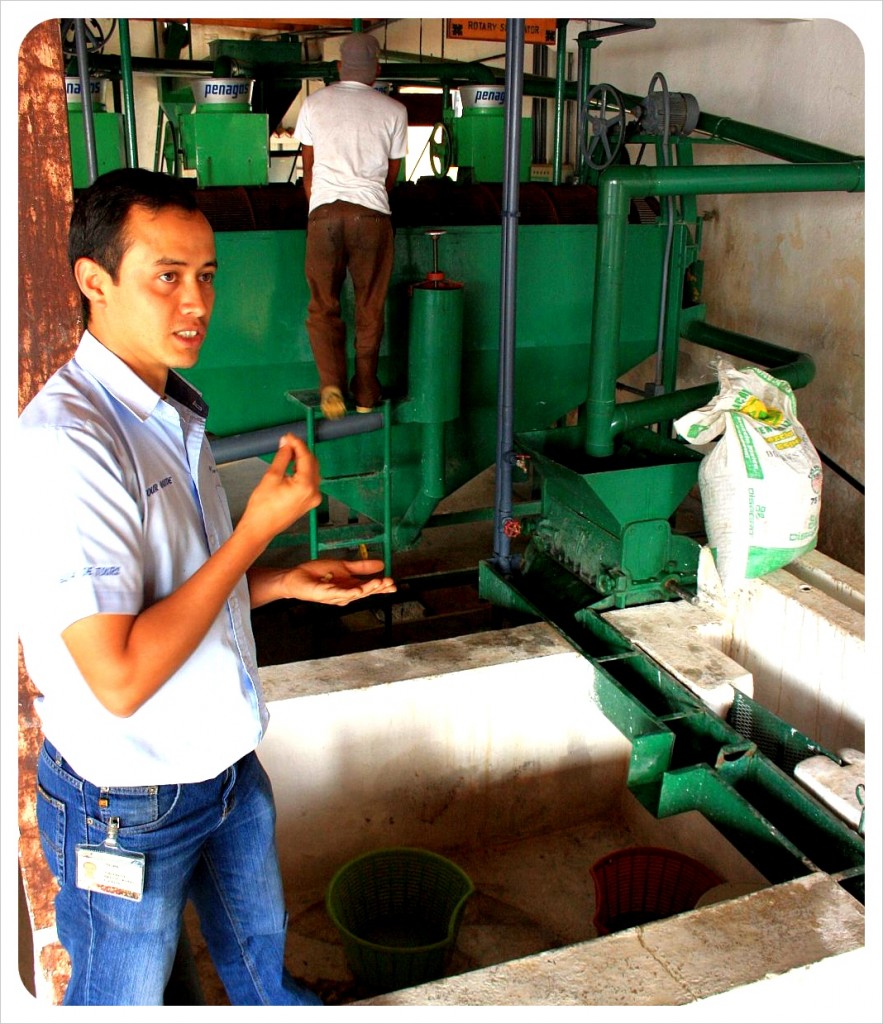 Our tour around the finca (finca means farm or plantation in Spanish) begins by hopping up into an enormous army-like Jeep with four other coffee-lovers and our English-speaking guide Josue. We drive to our first stop, where Josue shows us tiny beginnings of coffee plants, thousands of them lined up in a space the size of a football field. We learn that there are two kinds of coffee – Robust and Arabic. Because Arabic plants in Guatemalan soil would require pesticides to kill insect infestation, the coffee grown in Guatemala uses the Arabic plants on Robust roots. So, how does that work, we wonder. Do they tape the plants from one type onto the roots of the other? That must take ages, impossible. Yet this is exactly how it is done, and at an impressive speed.
Our tour around the finca (finca means farm or plantation in Spanish) begins by hopping up into an enormous army-like Jeep with four other coffee-lovers and our English-speaking guide Josue. We drive to our first stop, where Josue shows us tiny beginnings of coffee plants, thousands of them lined up in a space the size of a football field. We learn that there are two kinds of coffee – Robust and Arabic. Because Arabic plants in Guatemalan soil would require pesticides to kill insect infestation, the coffee grown in Guatemala uses the Arabic plants on Robust roots. So, how does that work, we wonder. Do they tape the plants from one type onto the roots of the other? That must take ages, impossible. Yet this is exactly how it is done, and at an impressive speed.
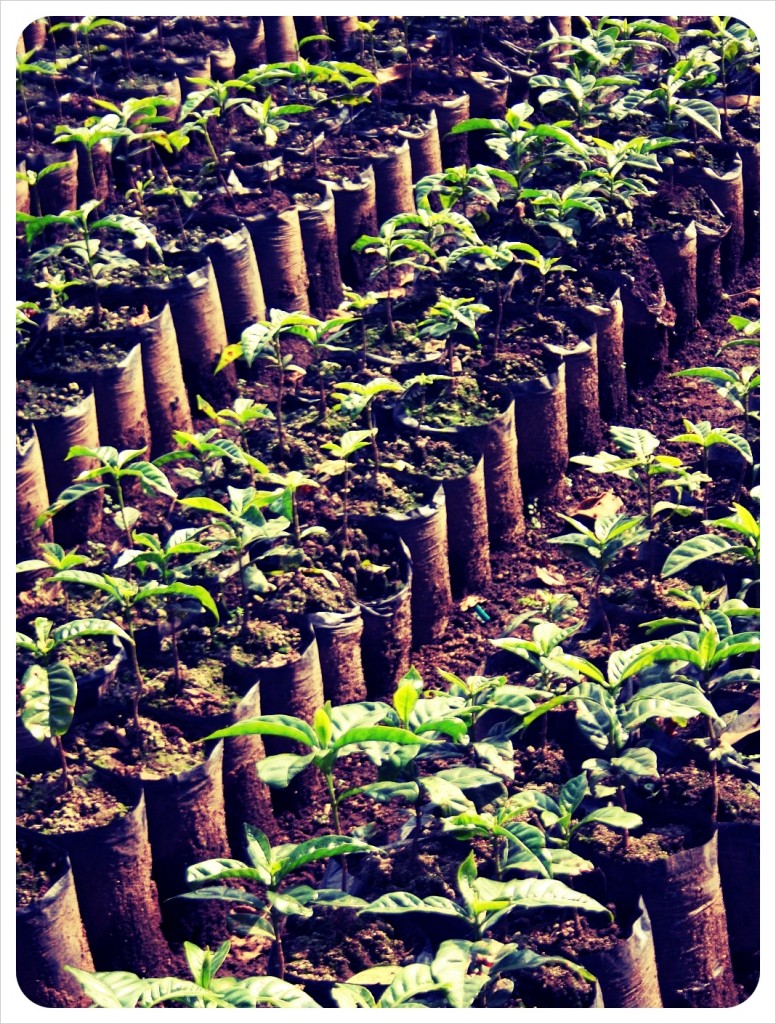
Six Guatemalan women work to tape together 1,300 plants per day at the finca. They must precisely slice millimeter-thin roots, wrapping, winding and taping them together before planting them. This work must be done by women, Josue explains, not because of their smaller, more delicate hands or a superior work ethic. The chemicals on a man’s hand actually somehow cause a much lower success rate – only 17% of plants joined by men survive, compared to 96% of the women’s work. Girl power!
Once the bushes are planted, it takes five years before yielding coffee berries, and after that, one coffee bush produces coffee only every three years. Put into perspective that is only 32 cups, or one pack of fresh roasted goodness, every three years. We spent a few minutes hunting for ripe berries and tasting them (sweet, bitter), and then hopped back in the monster Jeep for an adventurous and very up close ride through the plantation before heading to the processing area of the finca.
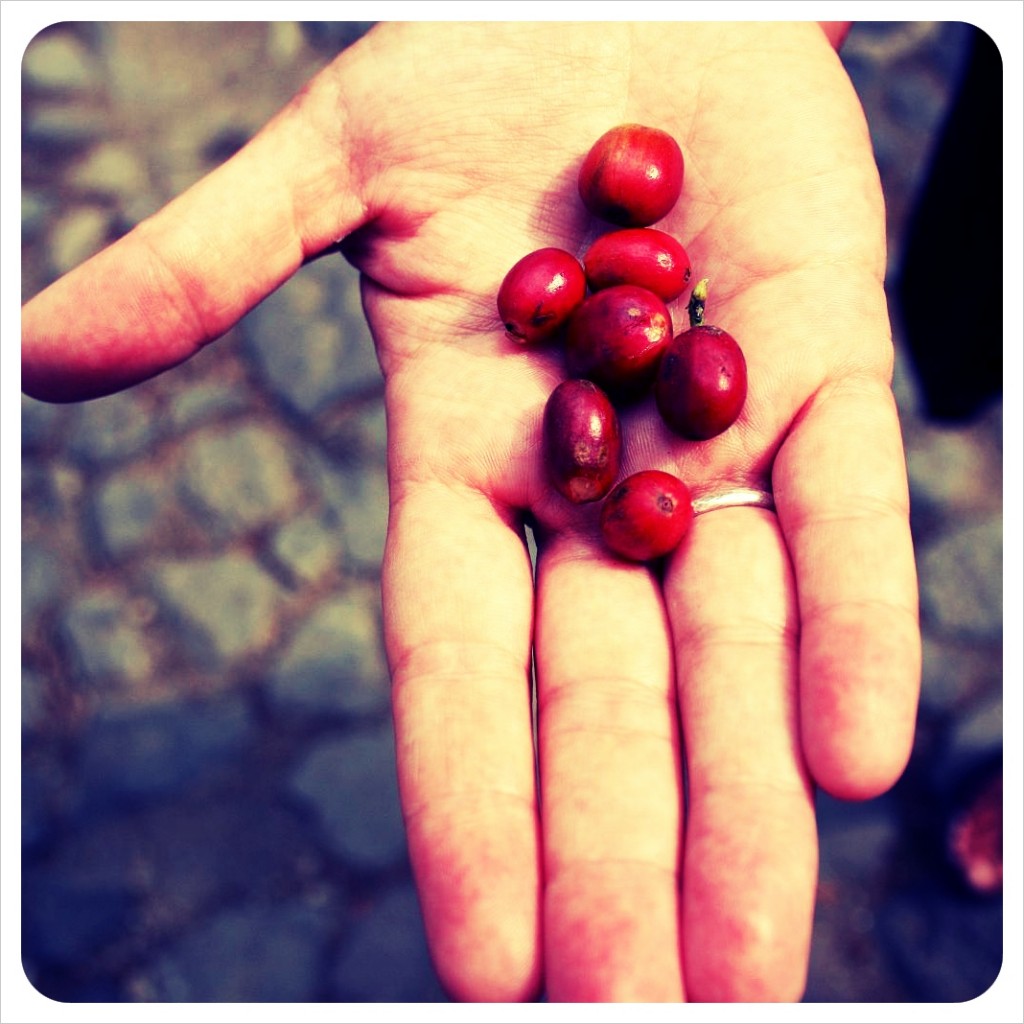
When the fruits ripen to a bright red, they are handpicked by coffee pickers who deposit them into baskets around their waists, carrying up to 25 pounds at a time until deposited at the processing area. This is done five times every day.
The actual coffee beans must be then extracted from the fruit and fermented. This is the first step that is not done by hand. A giant machine, similar to a kind of mill, squeezes and pops the beans out of the fruit.
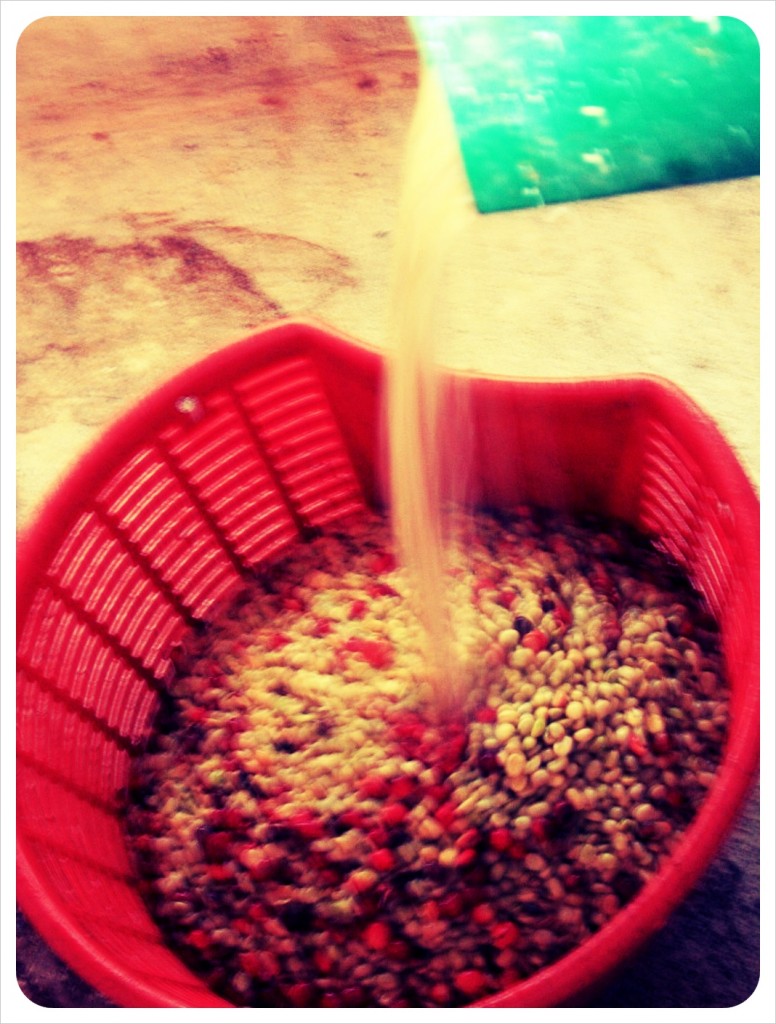
The coffee beans are then rinsed and laid to dry until the coffee master (what an awesome job title) decides that they are properly dried and ready to be roasted. The coffee master knows the beans are ready when they are a certain shade of gold and make the crisp sound of cornflakes when you let them sift through your hand. At this point, the beans are still far from the roasting machine.
First, there are still two remaining shells around the beans, both of which must be removed by different machines (which, Dani noted with glee, where made in Germany).
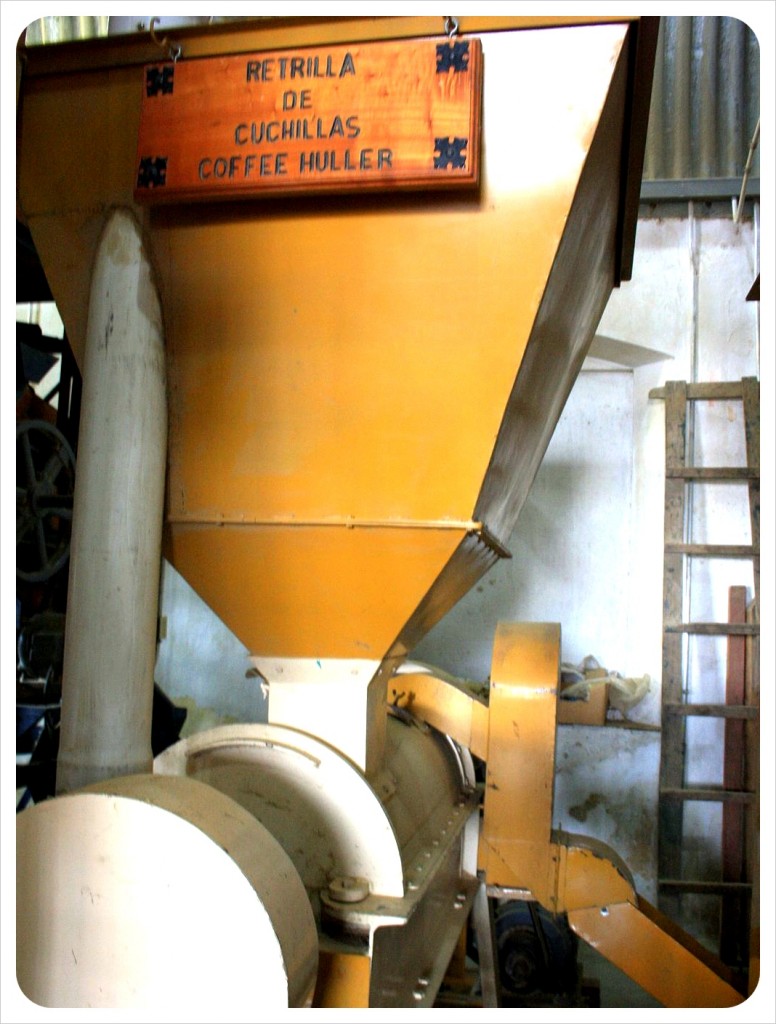 Then, the beans are loaded into a conveyor belt where, again, Guatemalan women hand separate beans according to their size, a la I Love Lucy. Small and large are used to produce less quality coffee or instant. Medium sized beans are the only ones used for the high quality export coffee.
Then, the beans are loaded into a conveyor belt where, again, Guatemalan women hand separate beans according to their size, a la I Love Lucy. Small and large are used to produce less quality coffee or instant. Medium sized beans are the only ones used for the high quality export coffee.
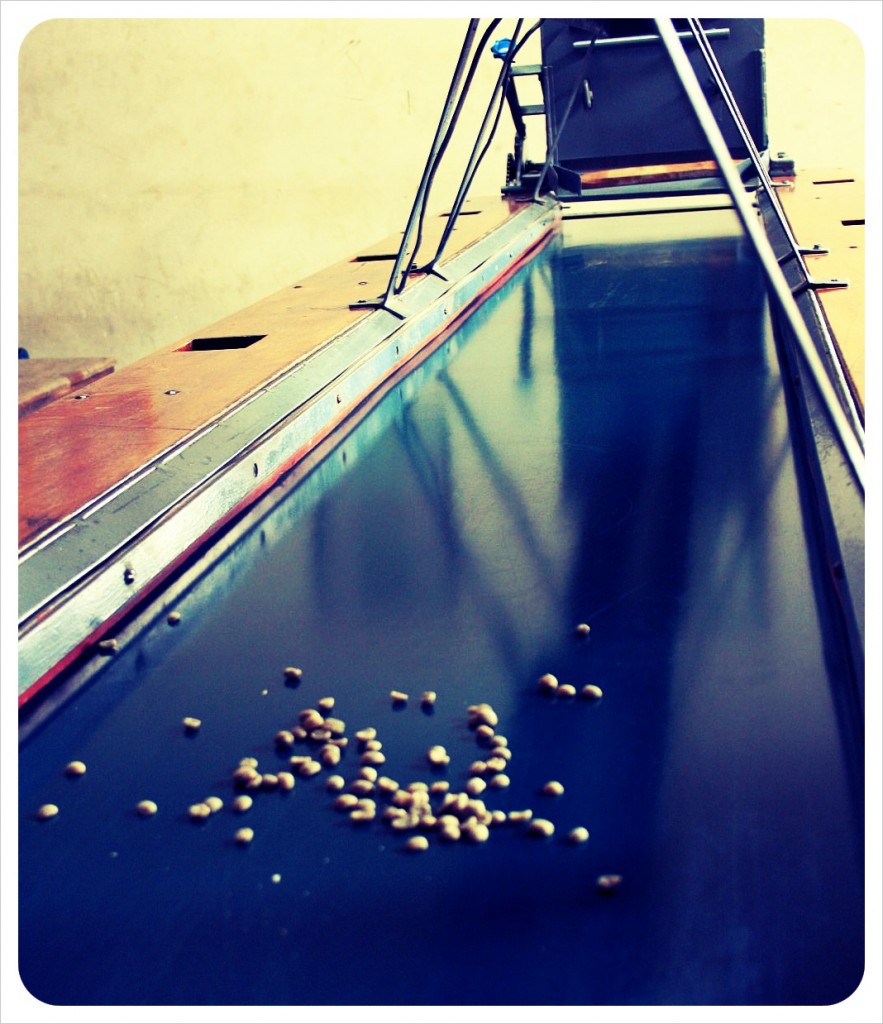 That’s right, almost all the best coffee is exported, hence our struggle to get our hands on the good stuff while we are here. In fact, Finca Filadelfia exports 80 % of its coffee, only 20 % are sold within the country, or on their website.
That’s right, almost all the best coffee is exported, hence our struggle to get our hands on the good stuff while we are here. In fact, Finca Filadelfia exports 80 % of its coffee, only 20 % are sold within the country, or on their website.
Finally, the beans are ready for roasting, which takes place in giant vats in the final, most wonderful smelling room of all. After the tour, Josue leads us to the café restaurant and treats us to a coffee, any way we like and we chat away over espressos, cappuccinos, and good old cups of strong coffee. Heaven!

Any wild guess which company buys up one-fourth of the entire global coffee population?
You got it. Starbucks. Now when will they open one within a 100 miles of here…
How to visit Finca Filadelfia
You can book a tour of Finca Filadelfia on their website.
There are different tours, from classic coffee tours to latte art tours and coffee tasting tours. Our classic coffee tour included a coffee tasting at the end.
You can also stay overnight at the Finca, and you can get married on the coffee farm. (Send them an email to inquire about weddings at Finca Filadelfia).
The resort is beautiful and has a swimming pool, hot tub and gym, and the rooms are held in elegant colonial-style decor. Check out the resort here.
More pictures of Finca Filadelfia:
[flickrslideshow acct_name=”Globetrottergirls” id=”72157625419141511″].
.


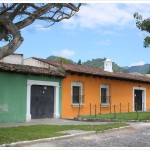

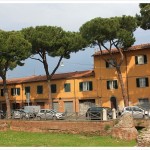
Abraham
Monday 17th of March 2014
Great post, but Guatemalan Coffee is not strong at all. Rarely do they ever have a bold flavor. I may be wrong, but I believe all the coffee that gets produced in Filadelfia is a light to medium roast and IS slightly higher in it's caffeine.
Kalong
Wednesday 4th of December 2013
Thanks so much for this post!! I'm heading to Antigua today, after volunteering in Honduras and I'm looking forward to doing this tour! How much does it cost btw?
Dani
Wednesday 4th of December 2013
Hi Kalong, I think it was around US$10. Enjoy your time in Antigua :)
Don Faust
Wednesday 13th of July 2011
Interesting - I never thought you'd be hard pressed to find good coffee in coffee-producing areas. We had no problem getting good Costa Rican coffee, but I don't know how strong their export business is.
I live for the smell of great roasted coffee beans... almost better than the coffee itself. I love opening up a new bag of beans and taking a hug whiff - I can't imagine what it would be like in the factory with the the whole room smelling of roasted coffee.
We live in coffee central in Seattle, home of Starbucks. It's seems like they are on every corner. And the city has these drive-up shacks, where you can order coffee from your car, but they rarely serve drip coffee - mostly only the fancy coffees, like cappuccino, etc. You might also be surprised that the coffee connoisseurs here don't think Starbucks is the best - there are a number of great alternatives.
jess
Wednesday 13th of July 2011
Hi Don, thanks for this comment! First, we've never been to Seattle, but now we're even more curious about the coffee culture there...Coffee snobbery is just an excuse to test even more coffee!
jamie
Wednesday 8th of December 2010
great shots! we chose to go to the rivals, la azotea instead. seems like they have a pretty similar tour. LOVE coffee.
jess
Saturday 11th of December 2010
@Jamie - We have heard of Azotea but we never saw it advertised in any of the travel agencies in Antigua - everyone always just had Finca Filadelfia. I can imagine that the tours are quite similar, but we're really happy to get to go on one!! Every coffee lover should do it :-)
Zablon Mukuba
Monday 6th of December 2010
its weird how people in Guatemala dont appreciate coffee as much of the rest of the world and the coffee is from there. i wish i was there, i love coffee
jess
Tuesday 7th of December 2010
@Zablon Thanks for stopping by Zablon. Glad to hear you love coffee! The Guatemalans would probably love to be able to afford their coffee, but unfortunately almost all of it gets exported and what stays here in only available at prices affordable to very high earners or foreigners. *sigh*